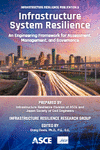Chapter 5
Applying the Framework
Publication: Infrastructure System Resilience: An Engineering Framework for Assessment, Management, and Governance
Abstract
The framework can be applied in part or in whole using conceptual or advanced computational models. On the whole, the framework is useful to identify the strategies for creating resilient infrastructure systems through a combination of pre-event planning and mitigations and post-event service restoration and repair/rebuild tactics capable of meeting community needs or performance targets. However, infrastructure and community resilience are developing fields of research and only initiating the operational stages in practice, resulting in the need for many improvements to existing and more importantly the development of new conceptual and computational models and processes. An analyst may use the framework by entering the process through any element. The infrastructure resilience framework for assessment, management, and governance does not include system-level or component-level designs. However, the use of this framework can provide guidance for system-level and component-level designs.
Get full access to this article
View all available purchase options and get full access to this chapter.
References
ASCE. 2017. Seismic evaluation and retrofit of existing buildings. ASCE 41-17. Reston, VA: ASCE.
Davis, C. A. 2019. “A proposed performance based seismic design process for lifeline systems.” In Earthquake geotechnical engineering for protection and development of environment and constructions, 1986–1993. Boca Raton, FL: CRC Press.
Deierlein, G. G., F. McKenna, A. Zsarnóczay, T. Kijewski-Correa, et al. 2020. “A cloud-enabled application framework for simulating regional-scale impacts of natural hazards on the built environment.” Front. Built Environ. 6: 1–18.
FEMA (Federal Emergency Management Agency). 2010. Design guide for improving school safety in earthquakes, floods, and high winds. FEMA P-424, Risk Management Series. Washington, DC: FEMA.
FEMA. 2023. A framework to establish lifeline infrastructure system service recovery objectives for seismic resilience. FEMA P-2234. Prepared by Applied Technology Council. Washington, DC: FEMA.
Infrastructure Resilience Division. 2021. Hazard-resilient infrastructure analysis and design, edited by B. Ayyub. ASCE Manuals and Reports on Engineering Practice No. 144. Reston, VA: ASCE.
LADWP (Los Angeles Department of Water and Power). 2019. Performance based seismic design for LADWP water system. Rep. No. AX-747 version 1. Prepared by C. Davis. Los Angeles: LADWP.
NIST (National Institute of Standards and Technology). 2015. Community resilience planning guide for buildings and infrastructure systems. NIST Special Publication 1190. Gaithersburg, MD: NIST.
Ouyang, M. 2014. “Review on modeling and simulation of interdependent critical infrastructure systems.” Elsevier: Reliab. Eng. Syst. 121: 43–60.
Van de Lindt, J. W., B. R. Ellingwood, H. Cutler, P. Gardoni, et al. 2019. “The structure of the interconnected networked community resilience modeling environment (IN-CORE).” In Proc., 2nd Int. Conf. on Natural Hazards & Infrastructure. Chania, Greece: National Technical Univ. of Athens [ISSN: 2623-4513].
Information & Authors
Information
Published In
Infrastructure System Resilience: An Engineering Framework for Assessment, Management, and Governance
Pages: 51 - 55
Editor: Craig Davis, Ph.D., P.E., G.E.
ISBN (Online): 978-0-7844-8508-8
Copyright
© 2023 American Society of Civil Engineers.
History
Published online: Sep 25, 2023
ASCE Technical Topics:
Authors
Metrics & Citations
Metrics
Citations
Download citation
If you have the appropriate software installed, you can download article citation data to the citation manager of your choice. Simply select your manager software from the list below and click Download.
